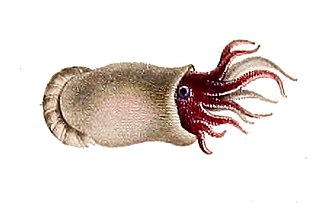
Spirulida is an order of cephalopods comprising one extant species and several extinct taxa.

Coleoidea or Dibranchiata is one of the two subclasses of cephalopods containing all the various taxa popularly thought of as "soft-bodied" or "shell-less". Unlike its extant sister group Nautiloidea, whose members have a rigid outer shell for protection, the coleoids have at most an internal shell called cuttlebone or gladius that is used for buoyancy or as muscle anchorage. Some species, notably incirrate octopuses, have lost their internal shell altogether, while in some it has been replaced by a chitinous support structure.

Orthocerida, also known as the Michelinocerida, is an order of extinct orthoceratoid cephalopods that lived from the Early Ordovician possibly to the Late Triassic. A fossil found in the Caucasus suggests they may even have survived until the Early Cretaceous, and the Eocene fossil Antarcticeras is sometimes considered a descendant of the orthocerids although this is disputed. They were most common however from the Ordovician to the Devonian.

Neocephalopods are a group of cephalopod mollusks that include the coleoids and all extinct species that are more closely related to extant coleoids than to the nautilus. In cladistic terms, it is the total group of Coleoidea. In contrast, the palcephalopoda are defined as the sister group to the neocephalopoda.

Trachyteuthis is a genus of extinct octopodiform cephalopods, comprising six species: T. hastiformis, T. latipinnis, T. nusplingensis, T. teudopsiformis, T. covacevichi and T. chilensis.
Pohlsepia mazonensis is a species of fossil organism with unknown affinity. Although it was originally identified as an extinct cephalopod, later studies denied that interpretation. The species is known from a single exceptionally preserved fossil discovered in the late Carboniferous (Pennsylvanian) Francis Creek Shale of the Carbondale Formation, north-east Illinois, United States.
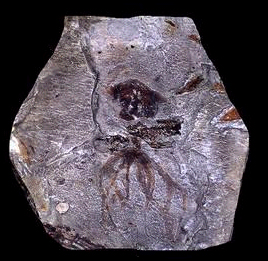
Palaeoctopus is an extinct genus of octopuses that lived during the Late Cretaceous. It contains one valid species, P. newboldi, which has been found in Lebanon.
The Ellesmerocerida is an order of primitive cephalopods belonging to the subclass Nautiloidea with a widespread distribution that lived during the Late Cambrian and Ordovician.
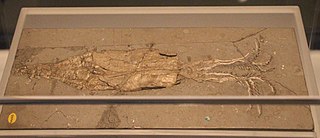
Belemnotheutis is an extinct coleoid cephalopod genus from the middle and upper Jurassic, related to but morphologically distinct from belemnites. Belemnotheutis fossils are some of the best preserved among coleoids. Remains of soft tissue are well-documented in some specimens, even down to microscopic muscle tissue. In 2008, a group of paleontologists even recovered viable ink from ink sacs found in several specimens.
Styletoctopus is an extinct genus of octopus. The genus consists of the single species Styletoctopus annae, which lived approximately 95 million years ago during the late Cenomanian,. It was first discovered in 2009 by a team led by Dirk Fuchs of Freie University in the Hâqel and Hjoula localities in Lebanon. Very few octopus species appear in the fossil record, as octopuses consist of soft tissue that usually decomposes before it has time to fossilize.
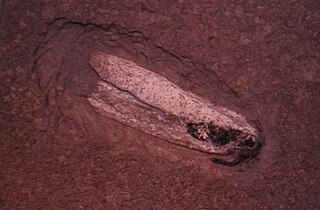
Teudopsis is a genus of the coleoid cephalopod family Teudopsidae, known only from Lower Jurassic gladii. It has been reported from Alberta, Canada and Europe. The life appearance of Teudopsis is probably best inferred by its close relative Trachyteuthis. A fossil with soft tissue preservation shows that this animal may have had two mantle fins, which may also be the case for Teudopsis.
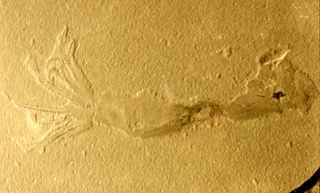
Ostenoteuthidae is an extinct family of cephalopods from Lower Jurassic of Italy. They had ten arms with unusual structure.
The cephalopods have a long geological history, with the first nautiloids found in late Cambrian strata.

Phragmoteuthida is an order of extinct coleoid cephalopods characterized by a fan-like teuthoid pro-ostracum attached to a belemnoid-like phragmocone.
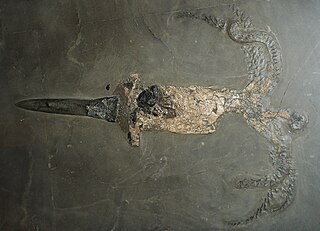
Belemnitida is an extinct order of squid-like cephalopods that existed from the Late Triassic to Late Cretaceous. Unlike squid, belemnites had an internal skeleton that made up the cone. The parts are, from the arms-most to the tip: the tongue-shaped pro-ostracum, the conical phragmocone, and the pointy guard. The calcitic guard is the most common belemnite remain. Belemnites, in life, are thought to have had 10 hooked arms and a pair of fins on the guard. The chitinous hooks were usually no bigger than 5 mm (0.20 in), though a belemnite could have had between 100 and 800 hooks in total, using them to stab and hold onto prey.

Cirrate octopuses possess a well-developed internal shell that supports their muscular swimming fins. This is in contrast to the more familiar, finless, incirrate octopuses, in which the shell remnant is either present as a pair of stylets or absent altogether.
This list, 2013 in molluscan paleontology, is a list of new taxa of ammonites and other fossil cephalopods, as well as fossil gastropods, bivalves and other molluscs that have been described during the year 2013.

Muensterella is a fossil stem-octopod known from a handful of specimens from the Late Jurassic lithographic limestones of southern Germany and the upper Cretaceous of Germany and Texas. Another indeterminate specimen of the Genus is known from the Tithonian Nordenskjöld Formation of Antarctica.
Groenlandibelidae is a family of coleoid cephalopods believed to belong to the spirulids.

Clarkeiteuthis is a genus of extinct belemnoid cephalopod known from the lower Jurassic in Germany and England. Described two species, C. conocauda and C. montefiorei are originally described as species of phragmoteuthid Phragmoteuthis, but got their own genus and moved to Diplobelida.
















